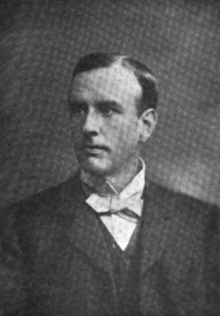Alan Gray
Alan Gray (23 December 1855 – 27 September 1935) was a British organist and composer.[1]
Alan Gray | |
|---|---|
 | |
| Born | 23 December 1855 |
| Died | 27 September 1935 (aged 79) |
| Occupation | Organist, composer |
Born in York, Gray attended St Peter's School and initially trained as a solicitor, qualifying in 1881.[2] But after musical studies with Edwin G Monk at York Minster he turned to music, studying as an undergraduate at Trinity College, Cambridge, where Charles Villiers Stanford came across him.[3] From 1883 until 1893 he was Director of Music at Wellington College. Other staff members in the music department at the same time were A H Fox Strangways and Hugh Allen.[2] In 1893 he returned to Cambridge to be organist at Trinity College, succeeding Stanford. One of his organ pupils was Ralph Vaughan Williams.[2] He remained there until 1930.[4] During the war Gray was badly affected, losing two of his three sons towards the end of the conflict.[3] He died in Cambridge, aged 79.[5]
Among his compositions are liturgical music for Morning and Evening Prayer and the Office of Holy Communion for use in the Church of England according to the Book of Common Prayer: the Magnificat and Nunc dimittis in F minor for double choir (1912); a setting of Holy Communion in G; and several anthems, including perhaps his best known piece, What are these that glow from afar? (1928, words Christina Rossetti), composed in memory of his sons lost in the war. There is also a collection of descants to various hymn tunes, several of which are still in use today (Common Praise [2000] includes four). During the war Gray composed a cycle of partsongs entitled 1914 and an Elegy (1915) for organ and strings (or solo organ) in memory of the composer W C Denis Browne, who had been the organ scholar at Clare College, Cambridge and who died in action in 1915.[3] There are a number of other works for organ, for violin solo and for voice and orchestra, set to religious and secular texts. The Magnificat and Nunc dimittis has been recorded by the Westminster Abbey Choir, conducted by James O'Donnell.[6]
References
- "Alan Gray". Cyber Hymnal. Archived from the original on 31 May 2012. Retrieved 23 January 2009.
- Humphreys, M and Evans, R. Dictionary of Composers for the Church in Great Britain and Ireland (1997) p 132
- Dibble, Jeremy. Notes to Hyperion CD A68301 (2020)
- "Gray, Alan (GRY873A)". A Cambridge Alumni Database. University of Cambridge.
- Trinity College Chapel Memorial
- Parry: Songs of farewell & works by Stanford, Gray & Wood, Hyperion CDA68301 (2020)
External links
- Free scores by Alan Gray in the Choral Public Domain Library (ChoralWiki) and at IMSLP
- Trinity College Chapel Memorial
- Psalm 96, sung by the combined choirs of St Paul's Cathedral and Her Majesty's Chapel Royal, conductor Andrew Carwood, 5 June 2012
- What Are These That Glow From Afar, sung by The Choir of Truro Cathedral, director David Briggs
| Cultural offices | ||
|---|---|---|
| Preceded by Charles Villiers Stanford |
Organist and Master of the Choristers of Trinity College, Cambridge 1893-1930 |
Succeeded by Hubert Stanley Middleton |